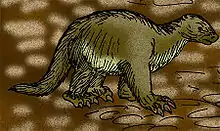Catonyx
Catonyx is an extinct genus of ground sloth of the family Scelidotheriidae, endemic to South America during the Pleistocene epoch.[1] It lived from 2.5 Ma to about 10,000 years ago, existing for approximately 2.49 million years .[2] The most recent date obtained is about 9600 B.P.[3][4]
| Catonyx | |
|---|---|
 | |
| Replica of a Catonyx skull at the Museo delle Scienze | |
| Scientific classification | |
| Kingdom: | |
| Phylum: | |
| Class: | |
| Superorder: | |
| Order: | |
| Suborder: | |
| Family: | |
| Genus: | †Catonyx Ameghino 1891 |
| Species | |
| |
Taxonomy

Catonyx was named by Ameghino in 1891. It was assigned to Scelidotheriinae by Gaudin in 1995.[5] Scelidotheriinae was elevated back to family status by Presslee et al. in 2019.[6]
Palaeoecology
The cranial anatomy of the species C. tarijensis indicates it may have been a browser which used its strong lips to grab vegetation,[7] and Santos Pereira et al. (2013) tentatively suggested browsing habits for C. cuvieri.[8] Isotopic analysis of Smilodon populator remains from Brazil indicates that Catonyx was one of its main prey items.[9]
Fossil distribution
Fossils of Catonyx have been uncovered in Brazil, the San José Formation of Uruguay, the Tezanos Pinto Formation of Argentina,[10] and the Tarija Valley of Bolivia.[7]
References
| Wikimedia Commons has media related to Catonyx. |
- McDonald, H. G.; Perea, D. (2002). "The large scelidothere Catonyx tarijensis (Xenarthra, Mylodontidae) from the Pleistocene of Uruguay". Journal of Vertebrate Paleontology. 22 (3): 677. doi:10.1671/0272-4634(2002)022[0677:TLSCTX]2.0.CO;2. JSTOR 4524258.
- PaleoBiology Database: Catonyx, basic info
- Turvey, Sam (2009). Holocene extinctions. Oxford University Press. pp. 20–33, 42–50, 352. ISBN 978-0-19-953509-5.
- Fiedal, Stuart (2009). "Sudden Deaths: The Chronology of Terminal Pleistocene Megafaunal Extinction". In Haynes, Gary (ed.). American Megafaunal Extinctions at the End of the Pleistocene. Springer. pp. 21–37. doi:10.1007/978-1-4020-8793-6_2. ISBN 978-1-4020-8792-9.
- Gaudin, T. J. (1995). "The ear region of edentates and the phylogeny of the Tardigrada (Mammalia, Xenarthra)". Journal of Vertebrate Paleontology. 15 (3): 672–705. doi:10.1080/02724634.1995.10011255. JSTOR 4523658.
- Presslee, S.; Slater, G. J.; Pujos, F.; Forasiepi, A. M.; Fischer, R.; Molloy, K.; Mackie, M.; Olsen, J. V.; Kramarz, A.; Taglioretti, M.; Scaglia, F.; Lezcano, M.; Lanata, J. L.; Southon, J.; Feranec, R.; Bloch, J.; Hajduk, A.; Martin, F. M.; Gismondi, R. S.; Reguero, M.; de Muizon, C.; Greenwood, A.; Chait, B. T.; Penkman, K.; Collins, M.; MacPhee, R.D.E. (2019). "Palaeoproteomics resolves sloth relationships" (PDF). Nature Ecology & Evolution. 3 (7): 1121–1130. doi:10.1038/s41559-019-0909-z. PMID 31171860. S2CID 174813630.
- "[PaleoMammalogy • 2020] Cranial Anatomy and Paleoneurology of the Extinct Sloth Catonyx tarijensis (Xenarthra, Mylodontidae) From the Late Pleistocene of Oruro, Southwestern Bolivia".
- dos Santos Pereira, I. C.; et al. (2013). "Record of the giant sloth Valgipes bucklandi (Lund, 1839) (Tardigrada, Scelidotheriinae) in Rio Grande do Norte state, Brazil, with notes on taphonomy and paleoecology". Journal of South American Earth Sciences. 43: 42–45. doi:10.1016/j.jsames.2012.11.004.
- Dantas, Mário André Trindade; Cherkinsky, Alexander; Lessa, Carlos Micael Bonfim; Santos, Luciano Vilaboim; Cozzuol, Mario Alberto; Omena, Érica Cavalcante; Silva, Jorge Luiz Lopes; Sial, Alcides Nóbrega; Bocherens, Hervé (2020-07-14). "Isotopic paleoecology (δ13C, δ18O) of a late Pleistocene vertebrate community from the Brazilian Intertropical Region". Revista Brasileira de Paleontologia. 23 (2): 138–152. doi:10.4072/rbp.2020.2.05. ISSN 2236-1715.
- "Fossilworks: Catonyx".
Further reading
- M. A. T. Dantas and M. H. Zucon. 2007. Occurrence of Catonyx cuvieri (Lund, 1839) (Tardigrada, Scelidotheriinae) in Late Pleistocene–Holocene of Brazil. Revista Brasileira de Paleontologia 10(2):129-132
- M. A. T. Dantas, M. H. Zucon, and A. M. Ribeiro. 2005. Megafauna Pleistocênica da fazenda elefante, Gararu, Sergipe, Brasil. Geociências 24(3):277-287
- A. M. Ghilardi, M. A. Fernandes, and M. E. Bichuette. 2011. Megafauna from the Late Pleistocene-Holocene deposits of the Upper Ribeira karst area, southeast Brazil. Quaternary International 245(2):369-378
- R. P. Lopes and J. C. Pereira. 2010. Fossils of Scelidotheriinae Ameghino, 1904 (Xenarthra, Pilosa) in the Pleistocene deposits of Rio Grande do Sul, Brazil. Gaea: Journal of Geoscience 6(1):44-52


